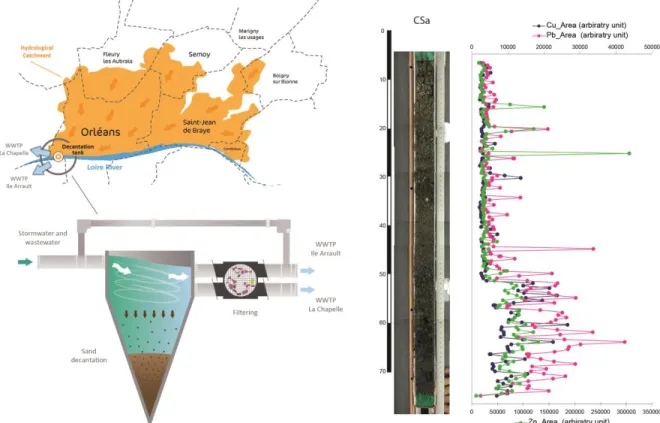HAL Id: insu-01288773
https://hal-insu.archives-ouvertes.fr/insu-01288773
Submitted on 15 Mar 2016
HAL is a multi-disciplinary open access
archive for the deposit and dissemination of
sci-entific research documents, whether they are
pub-lished or not. The documents may come from
teaching and research institutions in France or
abroad, or from public or private research centers.
L’archive ouverte pluridisciplinaire HAL, est
destinée au dépôt et à la diffusion de documents
scientifiques de niveau recherche, publiés ou non,
émanant des établissements d’enseignement et de
recherche français ou étrangers, des laboratoires
publics ou privés.
Challenging opportunities for an organic geochemistry of
the Anthropocene: Sediments in sewer systems as
archives of urban metabolism. A case study in Orléans
(France).
Alexandre Thibault, Jérémy Jacob, Anaëlle Simonneau, Claude Le Milbeau,
Mikael Motelica-Heino, Christian Di Giovanni
To cite this version:
Alexandre Thibault, Jérémy Jacob, Anaëlle Simonneau, Claude Le Milbeau, Mikael Motelica-Heino,
et al.. Challenging opportunities for an organic geochemistry of the Anthropocene: Sediments in
sewer systems as archives of urban metabolism. A case study in Orléans (France).. 27th International
Meeting on Organic Geochemistry, Sep 2015, Prague, Czech Republic. �insu-01288773�
Challenging opportunities for an organic geochemistry of the Anthropocene:
Sediments in sewer systems as archives of urban metabolism. A case study in
Orléans (France).
Alexandre Thibault
1, Jérémy Jacob
1,*, Anaëlle Simonneau
1, Claude Le Milbeau
1,
Mickael Motelica
1, Christian Di Giovanni
11 Institut des Sciences de la Terre d’Orléans, ISTO, UMR 7327 du CNRS/INSU, Université d’Orléans, BRGM, 1A rue de la Férollerie,
45071 Orléans, France.
(* corresponding author: jeremy.jacob@cnrs-orleans.fr)
Urban socio-ecosystems can be defined according to sociological, economic, political, philosophic or historical criteria. For geologists, cities can also be considered as hydrological catchments subjected to biogeochemical cycles of elements, molecules and minerals that are produced, transported and deposited. In this case, most of the transfers are realized at the surface (for stormwater) and underground (for the stormwater and wastewater systems), and can be combined or separative. Materials deposited in sewer networks are considered as an issue for sediment management but, from a paleoenvironemental, they constitute potential archives for the Anthropocene (i.e since AD 1950; Zalasiewicz et al., 2015), allowing an integrated retro-observation of urban metabolism. Similarly, most materials that transit in sewer systems are considered as pollutants, but paleoenvironmentalists could use them as tracers for urban metabolism. Depending on the type of materials preserved in the sedimentary archives (drugs such as analgesics or antibiotics, illict drugs, alcohol residues, pesticides, hydrocarbons, specific molecular biomarkers…), the recent history of a large spectrum of thematics (health, food consumption, biodiversity, transport, energy…) could be reconstructed at the city scale, affording local authorities diagnostic tools for evaluating past public policies.
In order to test whether paleoenvironmental approaches could be transposed to urban socio-ecosystems, we have analysed the sediments of short sedimentary cores drilled in a decantation tank located in Orléans (France; Figure 1). This decantation tank was built in 1942, is 17m deep and is presently saturated in sediments so that it does not properly filter sewer waters that are then directed towards wastewater treatment plants. To this respect, local authorities plan to clean out the tank and are undertaking various improvements. The tank is at the outlet of the sewer network that collects combined stormwater and wastewater over the whole hydrological catchment of Orléans and its suburb. A preliminary drilling afforded sedimentary sequences of maximum 1m length characterized by coarse grain silicoclastic deposits, sometimes sorted, interspaced with organic-rich layers (Figure 1). Some objects of evident anthropic origin could be distinguished such as a padlock, a coin dated back to 1999, and plastic and metallic residues of various origins. We also indentified in some layers grape and lemon seeds, and plant remains. XRF core scanner analyses performed on the whole cores revealed high levels of Zn, Pu and Cu all over the section, with organic layers being enriched. Ongoing work is focused on the analysis of “natural” and xenobiotic biomarkers that are studied through classical organic geochemistry analyses for natural biomarkers and through standard techniques employed in pollution studies for xenobiotics. The challenge, is off course, to transfer those techniques to a material of unprecented and extreme organic, elemental and mineral complexity. From the combined sedimentological, elemental and organic analyses, accompanied by radioelement dating, we will be able not only to discuss the nature of the materials (source, preservation…), but also the potential for these original archives to record the recent history of urban metabolism.
Fig. 1. (1) Location and cross section of the decantation tank at the outlet of the sewer network that collects stormwater and
wastewater over the city of Orléans before directing waters towards WWTP. (2) Csa core retrieved in the decantation tank with variations of Zn, Cu and Pb counts measured by XRF (EDYTEM, Chambéry).
References
Zalasiewicz et al., 2015. When did the Anthropocene begin? A mid-twentieth century boundary level is stratigraphically optimal. Quaternary International in press.
